In Access I have 2 tables, table_A and table_B. In col2 from table_A, I have an R function as cell value.
mdPatternChart<-function (x, Str_PathFile)
{
if (!(is.matrix(x) || is.data.frame(x)))
stop("Data should be a matrix or dataframe")
if (ncol(x) < 2)
stop("Data should have at least two columns")
R <- is.na(x)
nmis <- colSums(R)
R <- matrix(R[, order(nmis)], dim(x))
pat <- apply(R, 1, function(x) paste(as.numeric(x), collapse = ""))
sortR <- matrix(R[order(pat), ], dim(x))
if (nrow(x) == 1) {
mpat <- is.na(x)
} else {
mpat <- sortR[!duplicated(sortR), ]
}
if (all(!is.na(x))) { cat(" /\\ /\\\n{ `---' }\n{ O O }\n==> V <==")
cat(" No need for mice. This data set is completely observed.\n")
cat(" \\ \\|/ /\n `-----'\n\n")
mpat <- t(as.matrix(mpat, byrow = TRUE))
rownames(mpat) <- table(pat)
} else {
if (is.null(dim(mpat))) {
mpat <- t(as.matrix(mpat))
}
rownames(mpat) <- table(pat)
}
r <- cbind(abs(mpat - 1), rowSums(mpat))
r <- rbind(r, c(nmis[order(nmis)], sum(nmis)))
png(file=paste(Str_PathFile,".png",sep=""),bg="transparent")
plot.new()
if (is.null(dim(sortR[!duplicated(sortR), ]))) {
R <- t(as.matrix(r[1:nrow(r) - 1, 1:ncol(r) - 1]))
} else {
if (is.null(dim(R))) {
R <- t(as.matrix(R))
}
R <- r[1:nrow(r) - 1, 1:ncol(r) - 1]
}
par(mar = rep(0, 4))
plot.window(xlim = c(-1, ncol(R) + 1), ylim = c(-1, nrow(R) +
1), asp = 1)
M <- cbind(c(row(R)), c(col(R))) - 1
shade <- ifelse(R[nrow(R):1, ], mdc(1), mdc(2))
rect(M[, 2], M[, 1], M[, 2] + 1, M[, 1] + 1, col = shade)
adj = c(0, 0.5)
srt = 90
for (i in 1:ncol(R)) {
text(i - 0.5, nrow(R) + 0.3, colnames(r)[i], adj = adj,
srt = srt)
text(i - 0.5, -0.3, nmis[order(nmis)][i])
}
for (i in 1:nrow(R)) {
text(ncol(R) + 0.3, i - 0.5, r[(nrow(r) - 1):1, ncol(r)][i],
adj = 0)
text(-0.3, i - 0.5, rownames(r)[(nrow(r) - 1):1][i],
adj = 1)
}
text(ncol(R) + 0.3, -0.3, r[nrow(r), ncol(r)])
dev.off()
}
Now I would like to insert this into col2 of table_B. Col2 from both tables are memo. It works as
CurrentDb.Execute "insert into Table_B (Col1,Col2) select Col1,Col2 from Table_A"
But it does not work if I use DAO.recordset as below.
CurrentDb.Execute "insert into Table_B (Co1,Col2) values (2,'" & Rs_TableA.Fields("Col2") & "')"
And it gave a run-time error 3075 saying something is wrong with the syntax. I replaced ! and " in the function but it did not work. I also tried by saving its value in a string variable before inserting and it did not work either. As I need to loop through table_A, Can anyone help? Thanks!
